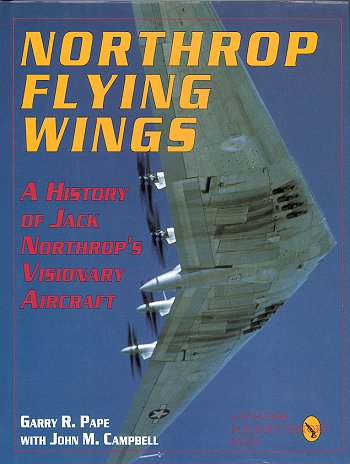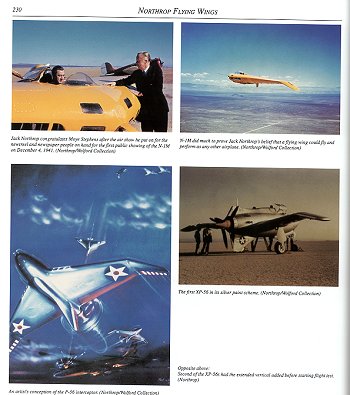|
BOOK: |
Northrop Flying
Wings: A History of Jack Northrop's Visionary Aircraft |
|
BY: |
Gary R. Pape with John M.
Campbell |
|
PUBLISHER
/PRICE: |
Schiffer
$49.00 |
|
REVIEW BY: |
Scott
Van Aken |
|
NOTES: |
|
 I don't know what it is about the subject, but
I just like flying wings. Whenever I see a book about them, I am eager to read
it. When I saw this volume in a book list. I immediately wanted to buy it. Then
I saw it was a Schiffer book and wasn't too sure, as Schiffer has a reputation
for producing some pretty poorly edited books.
I don't know what it is about the subject, but
I just like flying wings. Whenever I see a book about them, I am eager to read
it. When I saw this volume in a book list. I immediately wanted to buy it. Then
I saw it was a Schiffer book and wasn't too sure, as Schiffer has a reputation
for producing some pretty poorly edited books.
Throwing caution to the wind,
I decided to go for it and ordered the book. Much to my delight, it is a superb
volume and all that I could have hoped for. Let's get the specifics out of the
way. It is hardbound, 286 pages and printed in China. There are a huge number of
photographs, many of which I have never seen before. There are also a lot of
color photographs. 34 pages of them. Obviously the authors had access to
the Northrop history files. What I could have done without were the 12 pages of
color photos of the B-2. I'd have much rather seen some of Jack Northrop's
aircraft in its stead as all of the B-2 shots have been in other places a number
of times.
To get a bit more specific,
the book is broken down into 9 chapters. Each chapter gives a historical
perspective of the development of Jack Northrop's career in general, and his
work on flying wing aircraft specifically. Throughout the book, other aircraft
designed and developed by Northrop are given mention, but always, the thread of
the book concentrates on the wing. Some of the other planes discusses are
the Lockheed Vega, Northrop A-17, the N1M and N9M wings, the XP-56, the P-61,
XP-79, F-89, Snark and X-4. The book basically stops when Jack Northrop left his
company in the early fifties and his dream of the wing had died.
 Naturally, the emphasis of the book is on the
B-35 and B-49 flying wings. There is a great deal of detailed information on
systems and the politics involved in getting the wing program going. I found the
book eminently readable and quite fascinating. There is quite a bit of technical
information provided, but it is put into context of the situation at the
moment.
Naturally, the emphasis of the book is on the
B-35 and B-49 flying wings. There is a great deal of detailed information on
systems and the politics involved in getting the wing program going. I found the
book eminently readable and quite fascinating. There is quite a bit of technical
information provided, but it is put into context of the situation at the
moment.
The history of the wing is
fraught with problems and intrigue. While reading the book, it seemed like the
folks at Northrop were working uphill all the time in the development of the
aircraft. Some of the problems were technical as they worked in new areas of
aeronautics, but others were caused by the inability of the government and other
suppliers to get the folks at Northrop what they needed to enable them to get
the wing in the air. The trials and tribulations of just getting engines for the
aircraft would have driven anyone else crazy. At one time, there were a large
number of B-35 airframes sitting complete, but lacking the promised engines to
allow them to fly. When the engines did arrive, they were plagued with teething
troubles. I was truly amazed to read about how few flight hours the aircraft had
on them when they were finally scrapped.
There is also extensive
information on the XP-56 and the XP-79 programs, both of which I find quite
fascinating. These aircraft also had very little flight time before the programs
were terminated.
In addition, there are a
number of appendices giving such information as; a Chronology of wing
aircraft, First flights, Project designs, B-35 and B-49 flight logs, and
assigned serial numbers.
If you can't tell, I was
pretty psyched by the book as a whole. I found it to be an excellent read and if
you have only one book on the subject, this is the one to get.
Review sample courtesy of me
and my credit card!
If you would like your product reviewed fairly and quickly by a
site that has over 1,100 visits a day, please contact
me or see other details in the Note to
Contributors.
 I don't know what it is about the subject, but
I just like flying wings. Whenever I see a book about them, I am eager to read
it. When I saw this volume in a book list. I immediately wanted to buy it. Then
I saw it was a Schiffer book and wasn't too sure, as Schiffer has a reputation
for producing some pretty poorly edited books.
I don't know what it is about the subject, but
I just like flying wings. Whenever I see a book about them, I am eager to read
it. When I saw this volume in a book list. I immediately wanted to buy it. Then
I saw it was a Schiffer book and wasn't too sure, as Schiffer has a reputation
for producing some pretty poorly edited books.
 Naturally, the emphasis of the book is on the
B-35 and B-49 flying wings. There is a great deal of detailed information on
systems and the politics involved in getting the wing program going. I found the
book eminently readable and quite fascinating. There is quite a bit of technical
information provided, but it is put into context of the situation at the
moment.
Naturally, the emphasis of the book is on the
B-35 and B-49 flying wings. There is a great deal of detailed information on
systems and the politics involved in getting the wing program going. I found the
book eminently readable and quite fascinating. There is quite a bit of technical
information provided, but it is put into context of the situation at the
moment.